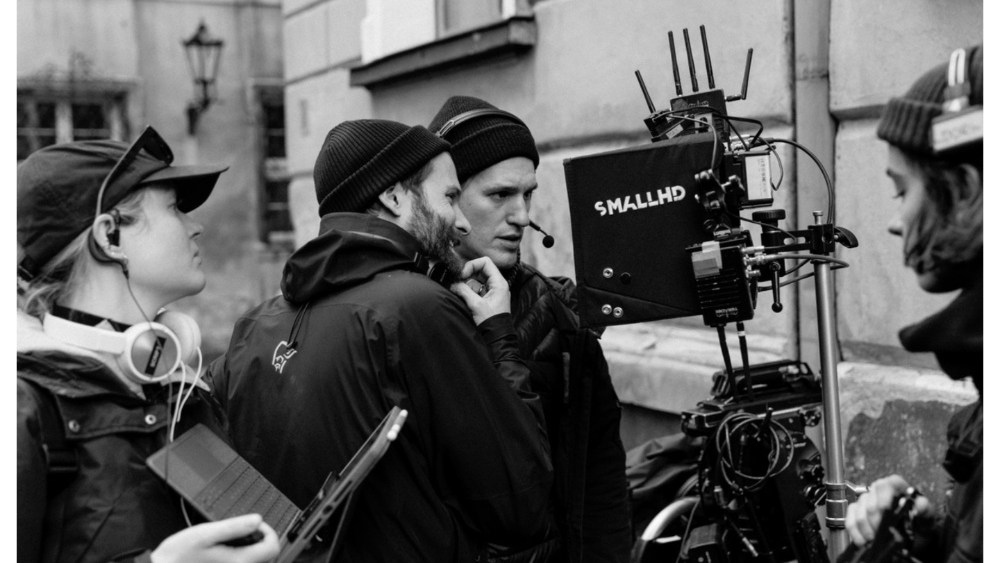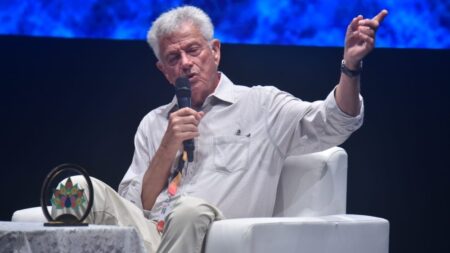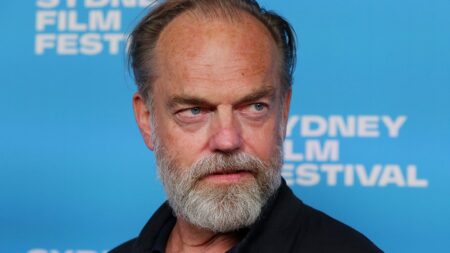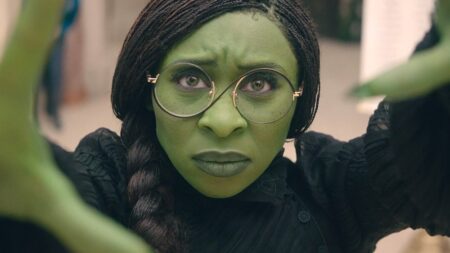When Polish cinematographer Michal Dymek first read the script for “The Girl With the Needle” – the winner of this year’s Camerimage main prize – he says he could instantly see the scenes in his mind: stark, shadowy images of a decrepit Danish slum, where sweatshop workers during World War I bend over creaking machinery.
He saw classical onscreen shot compositions framing crumbling, claustrophobic spaces where desperate people are ensnared.
“It was amazing, strong – like the best script I ever read,” says Dymek. He knew instantly that the film had to be in black and white, he says. “I wanted to create a time machine. All we know of that time is from black and white photographs so we had to film that.”
Over the two years of prep time, as the production grew into a Danish-Swedish-Polish project, says Dymek, Leica Hugo lenses were decided on to help create the distortions of old glass to remain true to the archival images of early 20th-century life of workers ruled by captains of the Industrial Age.
And the dismal settings created would naturally enough give rise to the story of a serial killer who promises relief – at a cost – for women who have babies they cannot afford to keep.
“The Girl With the Needle,” scripted by director Magnus von Horn and Line Langebek Knudsen, is based on actual events from one of the darker chapters of modern Danish history and follows textile factory worker Karoline as things spiral into dangers that grow deeper the more she fights fiercely to better her life.
“The Girl With the Needle”
Courtesy of Lukasz Bak
Dymek knew from working with von Horn on “Sweat,” a 2020 story of obsession and social media mythmaking, that the two would again find a visual language to express ominous forces closing in, he says.
To capture the bleak, decaying world of Karoline, played with remarkably quiet power by Vic Carmen Sonne, Dymek turned to locations not so far from the Lodz film school where he had studied. There, he knew, unlike what is now clean, streamlined Copenhagen, towns still have “everything crooked, broken and falling apart,” as the Danish city was a century ago.
For the dark, smothering interiors of the factory, the tenement where Karoline lives and the rooms above a candy shop where the true nature of evil takes her in, Dymek and van Horn decided on built sets where they could fully control the spaces. “It needed to be cramped, where people are squeezed and can’t move and there’s no light, no air,” says the cinematographer.
Filming with an Arri Mini LF, using a color sensor, would allow them to use filters on black and white imagery to help manipulate skin tones and spectrums of shadows, Dymek says.
They also wanted that world to feel “unpleasant,” he adds, “and to feel sweat, smoke, steam.”
The rhythm of the storytelling would be steady and formal, says Dymek, with static shots and long takes in which actors move through scenes without cuts, paying tribute to Polish New Wave cinema – but, he adds, they “didn’t want dogma. So you follow emotion: Cut when it feels like you should cut, hold the shot when it feels like you should hold.”
And just as important, he says, “allow the actors to lead the camera.”
Sonne’s constantly shifting moods as they swing between hope, fear and despair, are captured often with the slightest gesture just visible in a wide shot, accented by sudden shifts in light, at times overexposing during flashes of intense pain, Dymek says.
The camera, meanwhile, is just as constrained as Karoline’s life, with minimal movements – often forced to avoid allowing a glimpse of the 21st century to creep into the frame.
The settings by production designer Jagna Dobesz are remarkably evocative of the time, while making audiences feel viscerally the abject poverty of Karoline – and also sense the fresh air of her one fleeting chance at vast wealth.
Working closely with the spaces and the light they contained was an essential part of the work, says Dymek. “Any wall that was white was instantly painted,” he recalls, so that Karoline’s skin tone is invariably the lightest shade in the scene.
Trine Dyrholm as the malevolent Dagmar, based on the notorious Copenhagen serial killer, brings a different, more complex character to bear, says Dymek, and has a more technical approach than Sonne, who embraced improvisation on camera. That allowed the filmmakers to carefully choreograph her movements as her candy shop killer creates her lethal deceptions.
Inspired by classics of dark drama, from “Schindler’s List” to “In Cold Blood” and German expressionism, Dymek and von Horn tried to pay homage to great work that also journeys into places of madness, he says, in creating the psychological horror of “The Girl With the Needle.”
A surreal and sonorous soundscape created by Kim Dalum, Morten Pilegaard and Oskar Skriver, meanwhile, adds a distinct layer of the team’s own making, putting a fresh stamp on established conventions.
Reflecting on the shoot now, Dymek says, “I think this film was a tribute to how the masters taught us to think about cinema.”
Read the full article here








